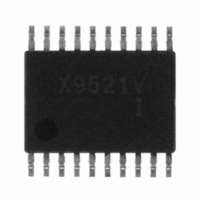X9521V20I Intersil, X9521V20I Datasheet - Page 6

X9521V20I
Manufacturer Part Number
X9521V20I
Description
IC LASR CTRLR 2CHAN 5.5V 20TSSOP
Manufacturer
Intersil
Type
Laser Diode Controller (Fiber Optic)r
Datasheet
1.X9521V20I.pdf
(24 pages)
Specifications of X9521V20I
Number Of Channels
2
Voltage - Supply
2.7 V ~ 5.5 V
Current - Supply
1.5mA
Operating Temperature
-40°C ~ 85°C
Package / Case
20-TSSOP
Mounting Type
Surface Mount
Lead Free Status / RoHS Status
Contains lead / RoHS non-compliant
Other names
X9521V20I-A
X9521V20I-A
X9521V20I-A
The data in the WCR is then decoded to select and
enable one of the respective FET switches. A “make
before break” sequence is used internally for the FET
switches when the wiper is moved from one tap position
to another.
Hot Pluggability
Figure 7 shows a typical waveform that the X9521 might
experience in a Hot Pluggable situation. On power-up,
Vcc applied to the X9521 may exhibit some amount of
ringing, before it settles to the required value.
The device is designed such that the wiper terminal
(R
stored in the DCP NVM), when the voltage applied to
Vcc exceeds V TRIP for a time exceeding t
Therefore, if
settle above V TRIP (Figure 7): then the desired wiper ter-
minal position is recalled by (a maximum) time:
t
tem hot plug conditions.
DCP Operations
In total there are three operations that can be performed
on any internal DCP structure:
—DCP Nonvolatile Write
—DCP Volatile Write
—DCP Read
A nonvolatile write to a DCP will change the “wiper
position” by simultaneously writing new data to the
associated WCR and NVM. Therefore, the new “wiper
position” setting is recalled into the WCR after Vcc of the
X9521 is powered down and then powered back up.
A volatile write operation to a DCP however, changes the
“wiper position” by writing new data to the associated
WCR only. The contents of the associated NVM register
pu . It should be noted that
Wx
) is recalled to the correct position (as per the last
t
trans is defined as the time taken for Vcc to
Vcc
0
t
trans
6
t
trans is determined by sys-
Figure 7.
pu
.
t
trans +
DCP Power-up
t
pu
X9521
remains unchanged. Therefore, when Vcc to the device
is powered down then back up, the “wiper position”
reverts to that last position written to the DCP using a
nonvolatile write operation.
Both volatile and nonvolatile write operations are
executed using a three byte command sequence: (DCP)
Slave Address Byte, Instruction Byte, followed by a Data
Byte (See Figure 9).
A DCP Read operation allows the user to “read out” the
current “wiper position” of the DCP, as stored in the
associated WCR. This operation is executed using the
Random Address Read command sequence, consisting
of the (DCP) Slave Address Byte followed by an
Instruction Byte and the Slave Address Byte again (Refer
to Figure 11.).
Instruction Byte
While the Slave Address Byte is used to select the DCP
devices, an Instruction Byte is used to determine which
DCP is being addressed.
The Instruction Byte (Figure 8) is valid only when the
Device Type Identifier and the Internal Device
Address bits of the Slave Address are set to
1010111. In this case, the two Least Significant Bit’s
(I1 - I0) of the Instruction Byte are used to select the
particular DCP (0 - 2). In the case of a Write to any of
the DCPs (i.e. the LSB of the Slave Address is 0), the
Most Significant Bit of the Instruction Byte (I7), deter-
mines the Write Type (WT) performed.
If WT is “1”, then a Nonvolatile Write to the DCP occurs.
In this case, the “wiper position” of the DCP is changed
by simultaneously writing new data to the associated
WCR and NVM. Therefore, the new “wiper position” set-
ting is recalled into the WCR after Vcc of the X9521 has
been powered down then powered back up
Maximum Wiper Recall time
Vcc (Max.)
V TRIP
t
September 21, 2010
FN8207.2











